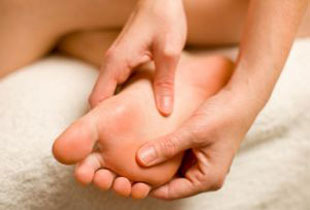Today's post from indypodiatry.com (see link below) is a useful list of tips to avoid foot problems with neuropathy. The lack of sensation in toes and feet; or even the excess sensation in the same areas can lead to misleading signals and all kinds of accidents and mishaps. For these reasons it's important to take care of your feet and keep an eye out for injuries you may not be feeling or noticing. It's not a comprehensive list but there are some sensible ideas here.

Michael J..Helms:DPM Shelley F Bowers DPM
One of the potential problems associated with diabetes is the loss of the ability to feel things in the feet. This condition results in an inability to feel pain or other stimulus. This condition is known as diabetic peripheral neuropathy.
Our ability to feel pain is an important protective mechanism. Pain warns us to move our feet away from a hot register. It tells us we stepped on a piece of glass and we need to get the glass out of our foot. Pain let’s us know when we break a bone in our foot and prompts us to get treatment. Diabetics with neuropathy lack the important feedback of knowing when there is an injury to the foot. A diabetic with neuropathy can break a foot bone and not be aware of this because they do not feel the pain. The results can be devastating, including the potential loss of a foot or leg to amputation.
Steps to Avoid Serious Foot Problems
If you have diabetes and a loss of protective sensation there are steps you must take to help you avoid serious foot problems. Here is a list of important tips to help guide you:
Inspect your feet daily. Since you cannot feel when a problem is present you need to use your vision to replace your loss of sensation. Use a mirror to see the bottom of your feet. Call Drs. Helms or Bowers if you find new redness, swelling, bruising, cuts or other changes.
Always wear shoes, even around your home. The shoes will act as a protective barrier.
Change into different shoes once or twice each day. This allows for changing pressure point on the bottom of your feet and decreases the risk of developing a callus or sore on your feet.
Make sure your shoes fit well and are not overly worn. You should be professionally fit, either in our office or at stores where the sales staff knows how to measure feet and has experience working with diabetic patients. Our office can direct you to the appropriate stores.
Use open toe support hose. If you wear support hose prescribed by one of your doctors, make sure you use the type with open toes. This can help prevent possible irritation or the development of sores on your toes.
Always wear special shoe inserts made by your doctor. If Dr Helms or Dr Bowers has made or dispensed special shoe inserts, be sure to always wear these in your shoes. These inserts can help prevent foot sores or foot ulcerations.
Ask Dr Helms or Dr Bowers about personal digital thermometry. This is a simple, at home tool you can use to help detect many diabetic foot problems in their early stages. Early detection will lead to treatment that might prevent foot sores, ulcerations or amputations.
Exercise on a regular basis. Studies have shown that patients with diabetic loss of protective sensation that engage in aerobic exercise have fewer amputations.
Be sure to clear this with your medical doctor before beginning a new program. Also, be sure to discuss appropriate exercise shoes and socks with Dr Helms or Dr Bowers.
NEVER trim your own calluses or corns. Corns and calluses occur in places where there is rubbing or too much pressure. Corns and calluses need to be trimmed back on a regular basis because they can lead to diabetic foot ulcers. These should only be trimmed by your podiatrist.
Do not have pedicures. Diabetics with loss of protective sensation should have their toenails trimmed at the podiatrists office.
http://www.indypodiatry.com/diabetic-neuropathy.php
No comments:
Post a Comment
Note: only a member of this blog may post a comment.